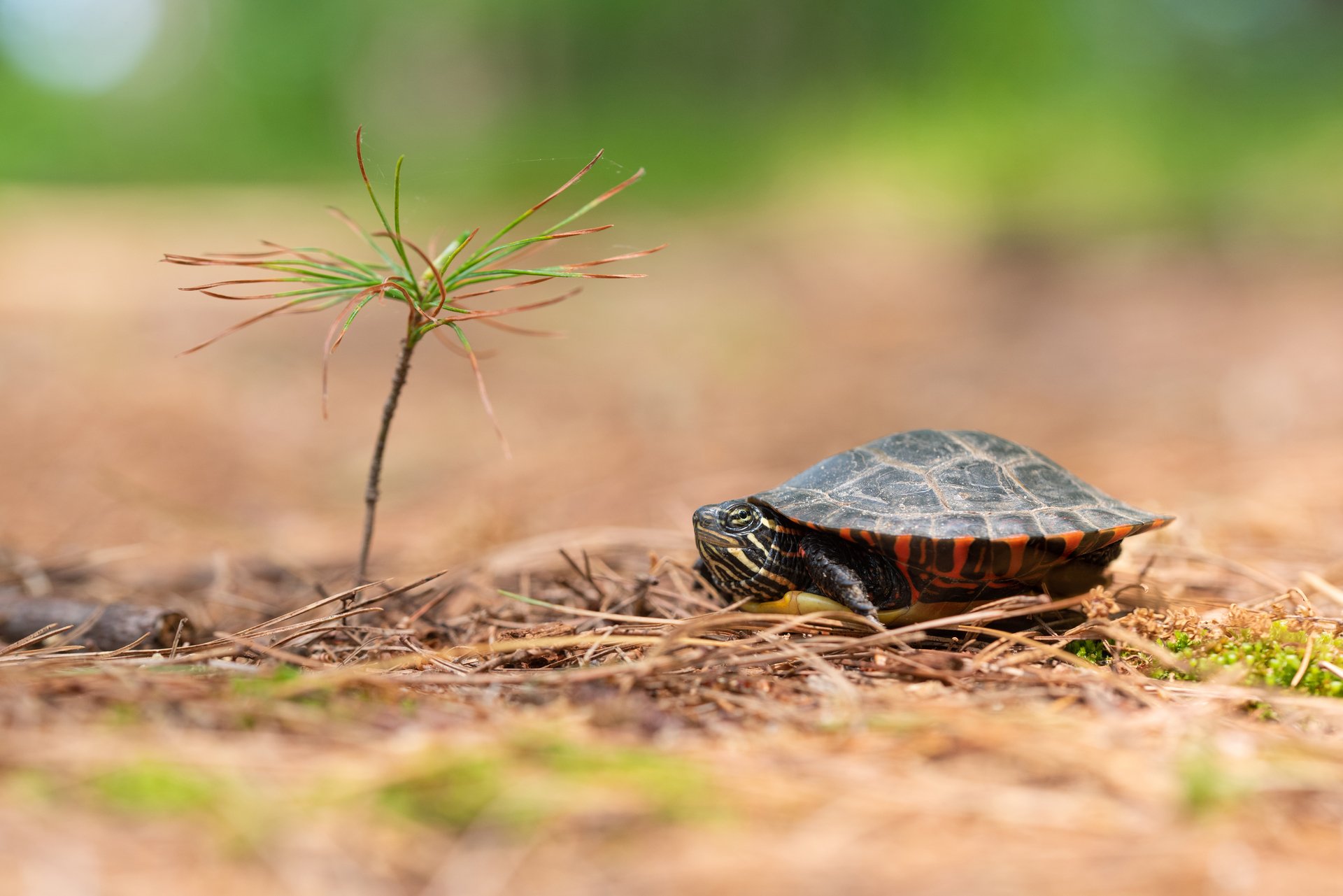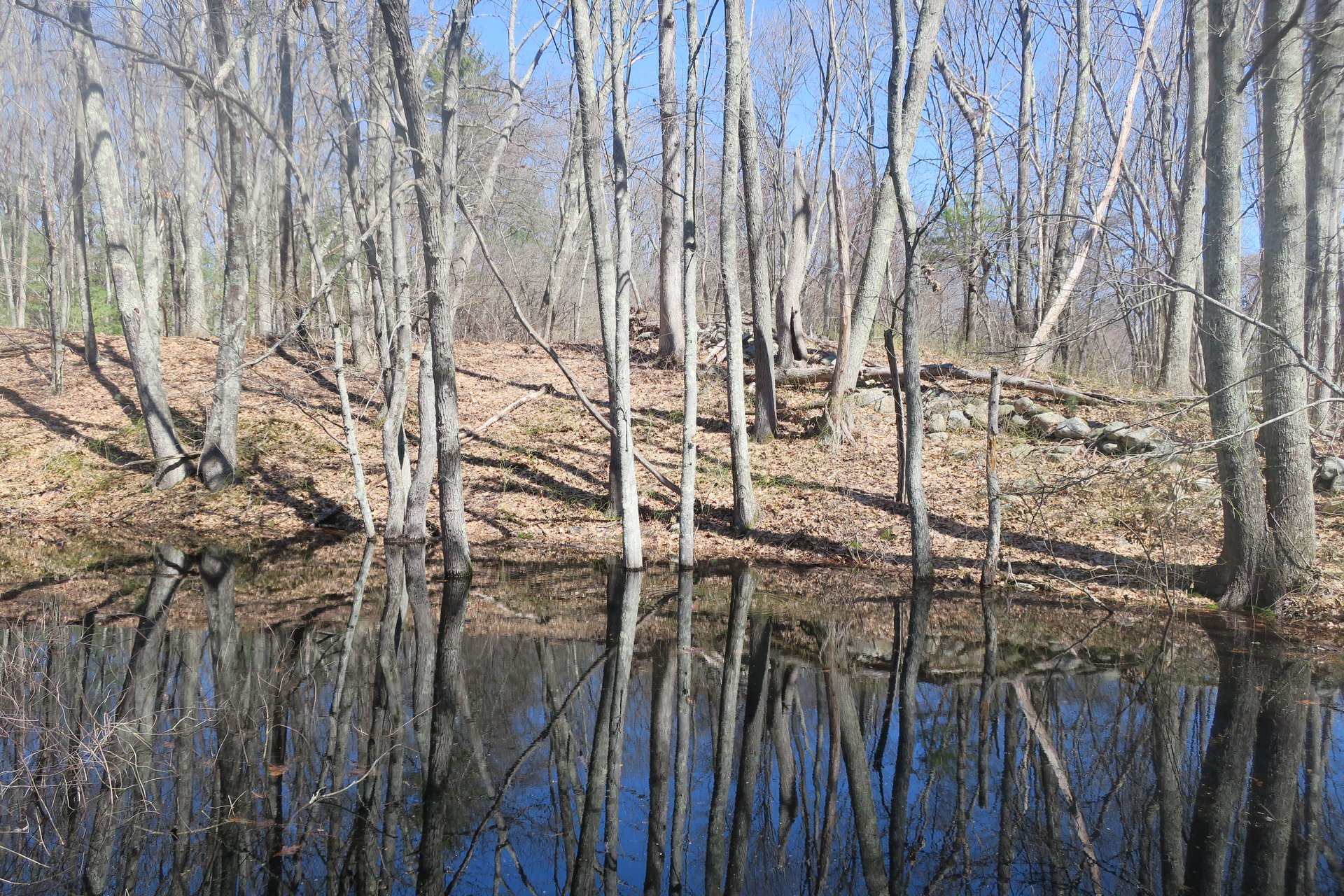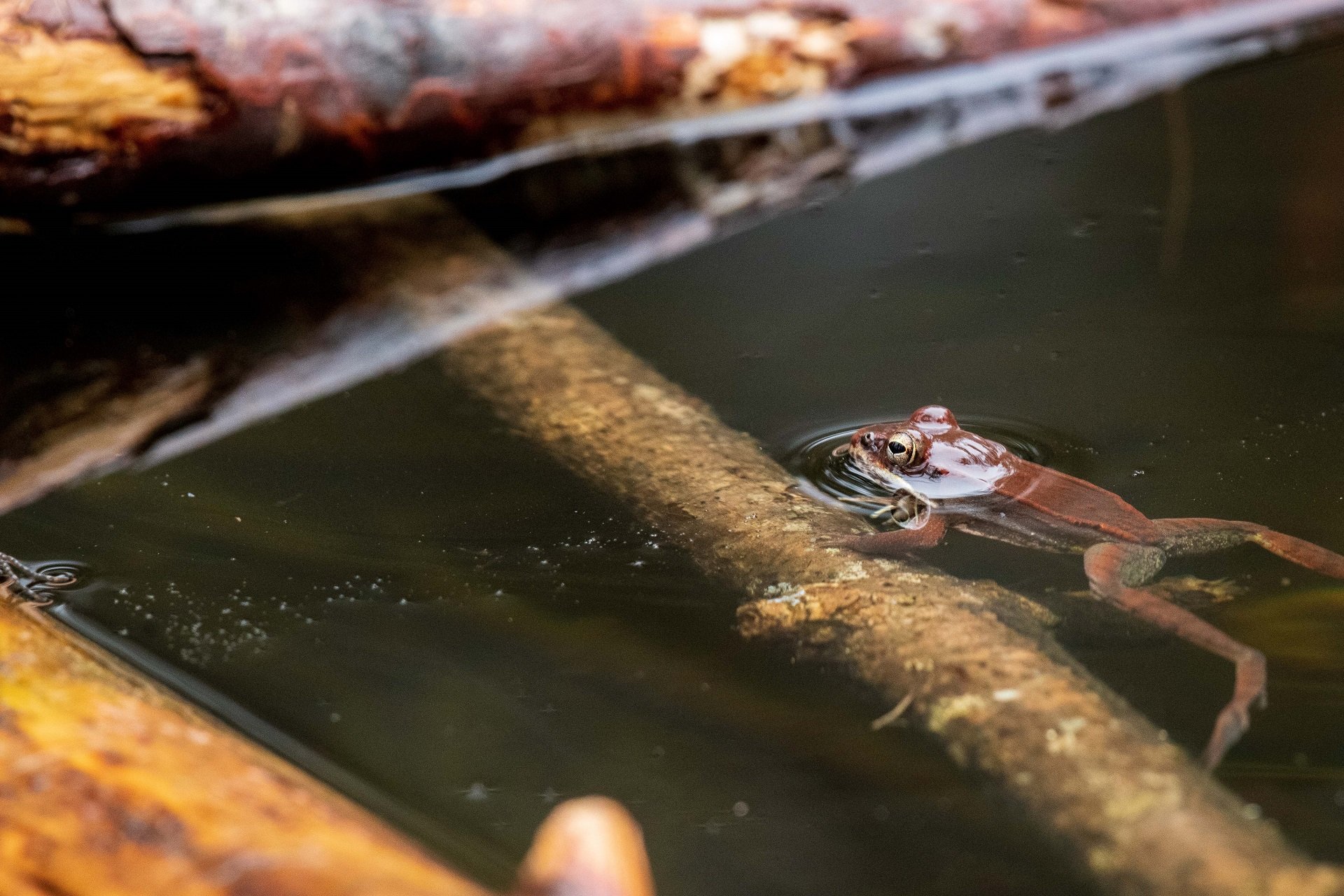Reptiles & Amphibians
Snakes
Snakes are reptiles, like turtles and lizards. Early snakes first appeared during the time of the dinosaurs, and they now live on every continent except Antarctica. Although snakes often get a bad rap, most species aren’t venomous. They also provide a valuable service by eating potential pests, like mice and slugs.
In fact, snakes have more to fear from us than we do from them. Many species have suffered from persecution and habitat loss. Three snake species are listed as Endangered in Massachusetts, and one is listed as Threatened.
Snake Species in Massachusetts
There are 14 species of snakes that call Massachusetts home, most of which are non-venomous, including those most often found in yards or basements: the Eastern Garter Snake and Eastern Milk Snake. The two venomous species, the Timber Rattlesnake and Northern Copperhead, are very rare, and prefer rocky, forested hillsides.
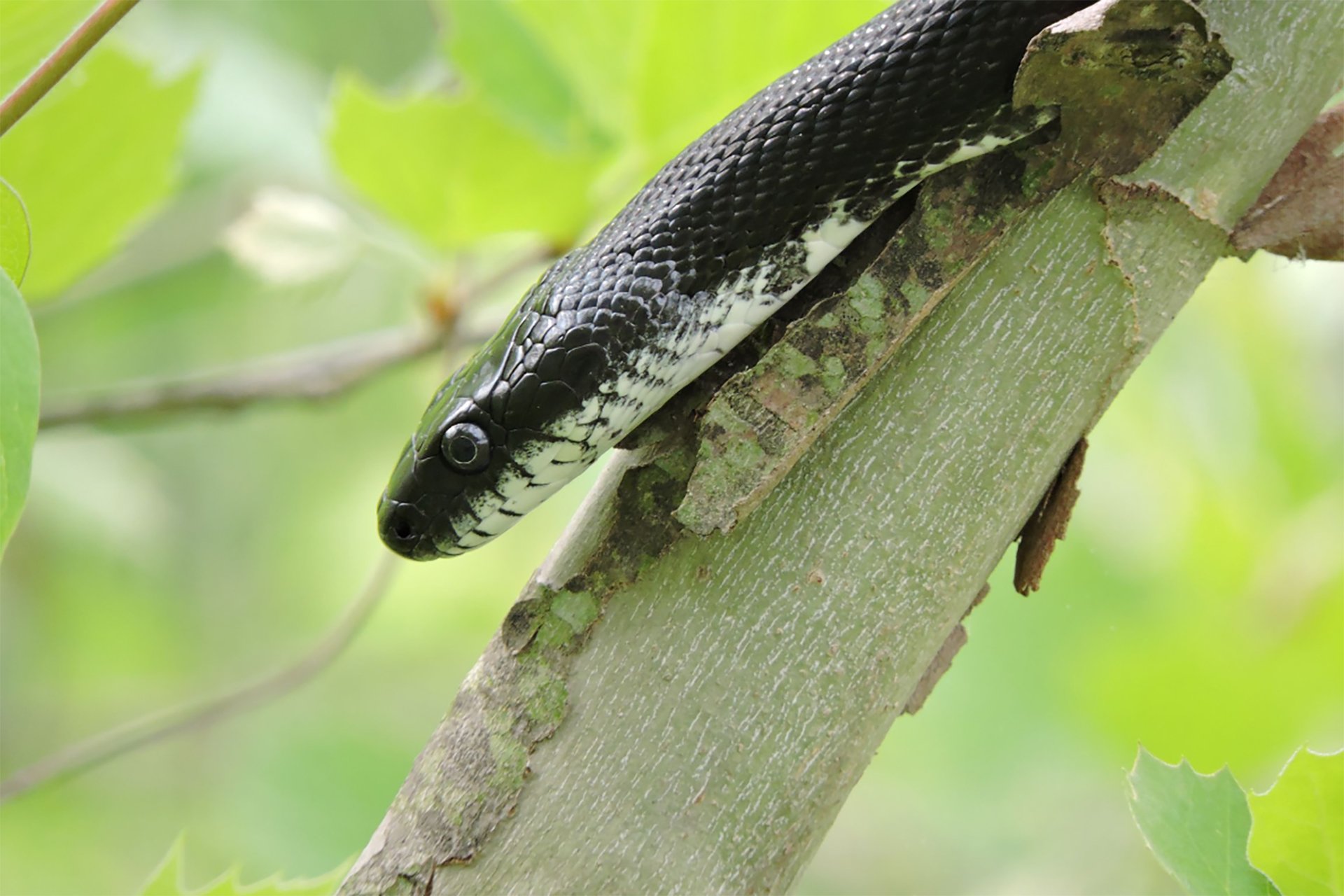
Eastern Ratsnake (Pantherophis alleghaniensis)
The largest snake in Massachusetts, the Eastern Ratsnake grows up to 101”. It is found in the Connecticut River Valley and eats small mammals, birds, and amphibians. Adults are mostly black, with a white throat, and juveniles are mottled grey. Its scales are lightly keeled (they have a small ridge, as on the bottom of a boat).
Status: Endangered in Massachusetts, and, under the Massachusetts Endangered Species Act, it is illegal to kill, harass, or possess this snake.
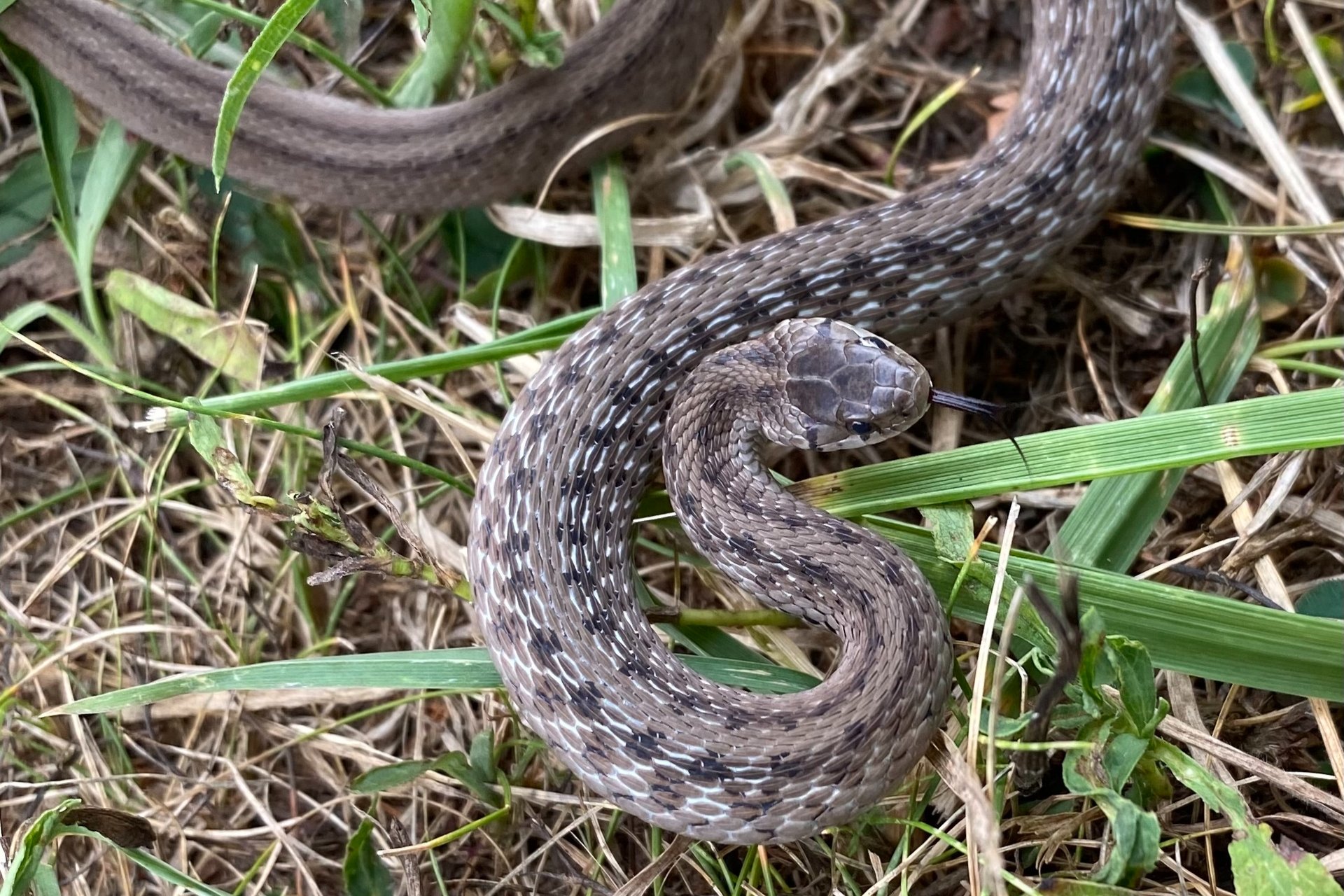
DeKay’s Brownsnake (Storeria dekayi)
Dekay's Brownsnake is often seen in urban and suburban areas, where it eats pests like slugs. It is fairly small, between 9-13” long, and is skittish and shy. It is creamy beige-brown, with keeled scales, and dark brown spots down the back.
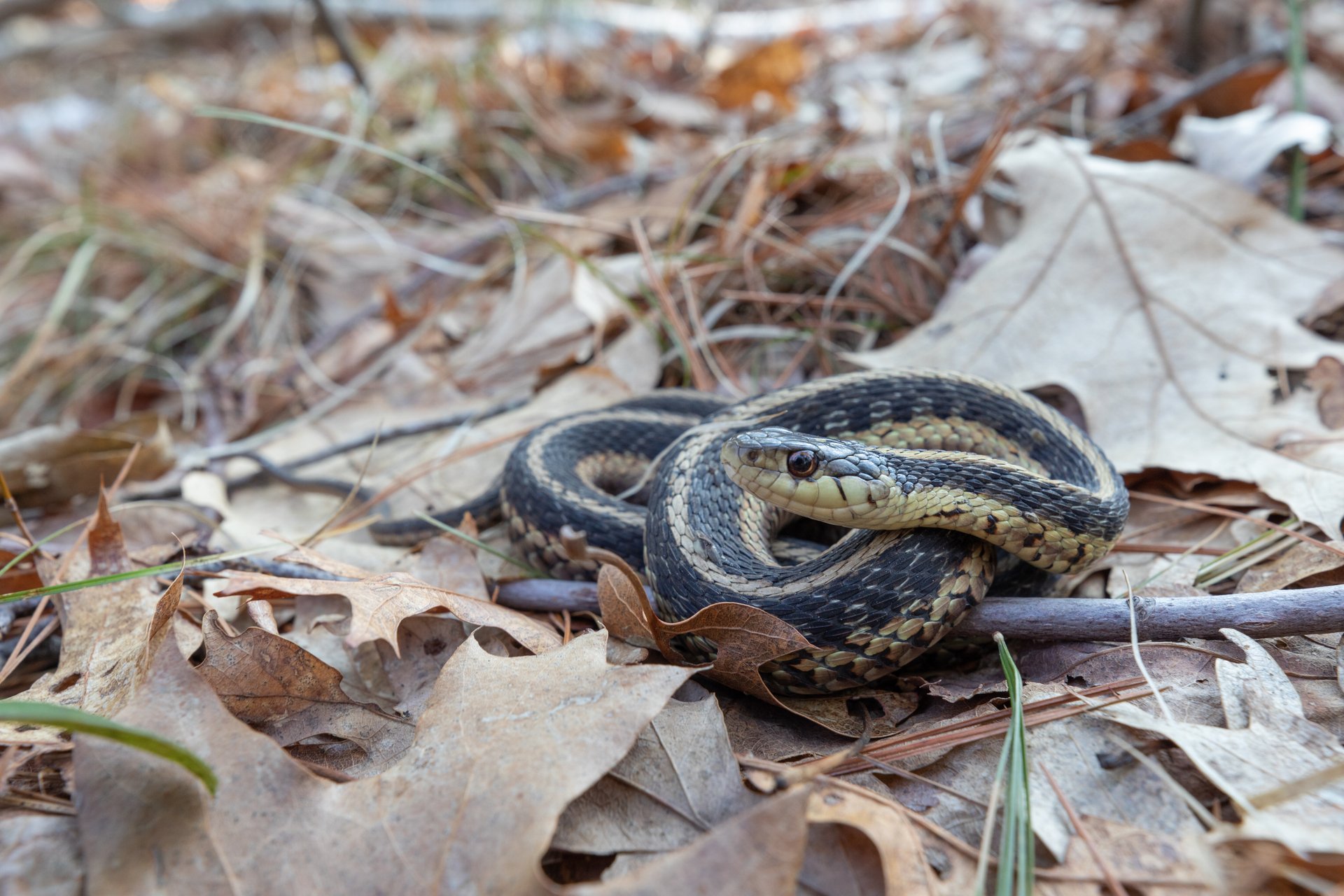
Eastern Gartersnake (Thamnophis sirtalis)
The Eastern Garter Snake is one of our most common snakes. It has long stripes down its body but lacks the burgundy stripe and white eye spot of the rarer Eastern Ribbonsnake. It eats amphibians, fish, small mammals, earthworms, and sometimes insects. People often mistakenly call this snake a “garden snake,” because it can sometimes be seen in gardens. However, the name “garter snake” comes from the old fashion of wearing garters—strips of fabric that held up stockings.
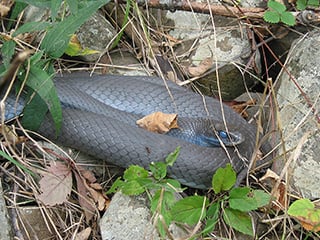
North American Racer (Coluber constrictor)
The North American Racer grows fairly large, up to 73” long. Like the Eastern Ratsnake, it is mostly black, but it has smooth scales. Young snakes are mottled grey-blue and brown. This snake may be more prone to striking if threatened, but this behavior is a bluff; it is non-venomous.
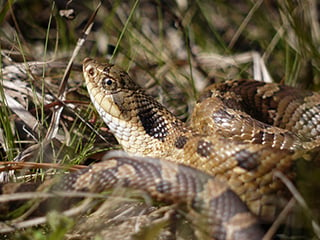
Eastern Hog-nosed Snake (Heterodon platyrhinos)
This snake is named for its turned-up nose. Its body color varies from yellow to brown to black, and it has keeled scales. When threatened, this harmless snake may flatten its head like a cobra and then play dead. Its diet is varied, but it prefers to eat toads.
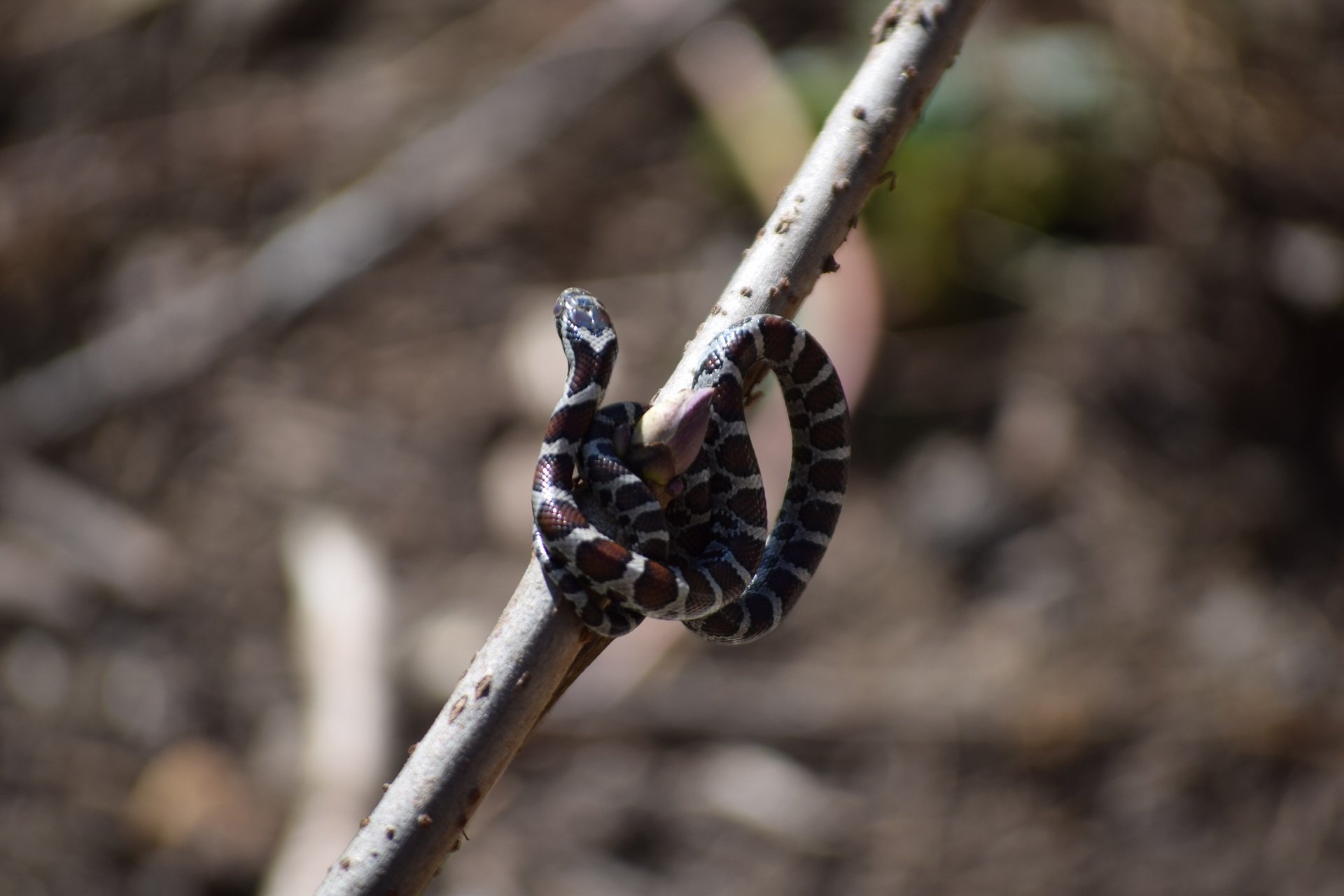
Milksnake (Lampropeltis triangulum)
The Milksnake has a mottled grey, brown, and reddish body. This non-venomous snake is often confused for a rattlesnake, especially when it vibrates its tail, but it lacks the rattle, keeled scales, and cat-like pupils. It is found in fields, woodlands, rocky hillsides, and wetland edges and primarily eats small mammals.
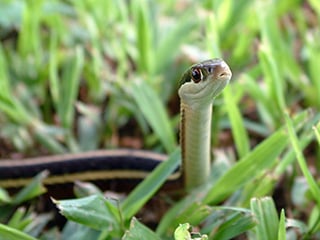
Eastern Ribbonsnake (Thamnophis sauritus)
Elegant and slender, the Eastern Ribbonsnake has keeled scales. It looks much like an Eastern Garter Snake, in that it has yellow and black stripes, but it also has thick burgundy stripes and a white mark by the eye. It lives in wetlands and eats amphibians, fish, and sometimes insects.
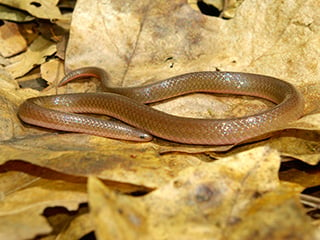
Eastern Wormsnake (Carphophis amoenus)
The Eastern Wormsnake is smooth and pinkish-gray—much like a worm—and, in fact, earthworms are its main prey. It’s small, usually measuring from 7-11” long. This species is found in the Connecticut River Valley.
Status: Threatened in Massachusetts, and, under the Massachusetts Endangered Species Act, it is illegal to kill, harass, or possess this snake.
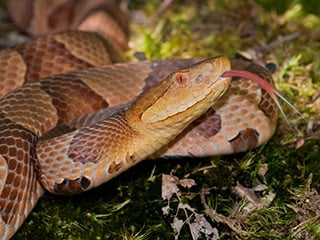
Copperhead (Agkistrodon contortrix)
Venomous, the Copperhead is extremely rare. It has a thick, heavy body, with keeled scales, a triangular head, and a thin, cat-like pupil. Its brown and orange body is well-camouflaged against the forest floor.
Status: Endangered in the Massachusetts, and, under the Massachusetts Endangered Species Act, it is illegal to kill, harass, or possess this snake.
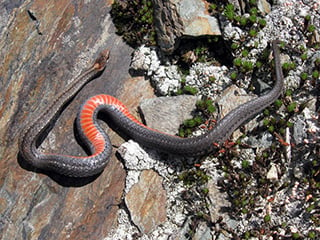
Red-bellied Snake (Storeria occipitomaculata)
Like the DeKay’s Brownsnake, the Northern Red-bellied Snake is small, with keeled scales and a brown, gray or black back, and bright coral red or orange belly. It often eats slugs and worms. However, it is generally less tolerant of urban and suburban areas than the Brownsnake.
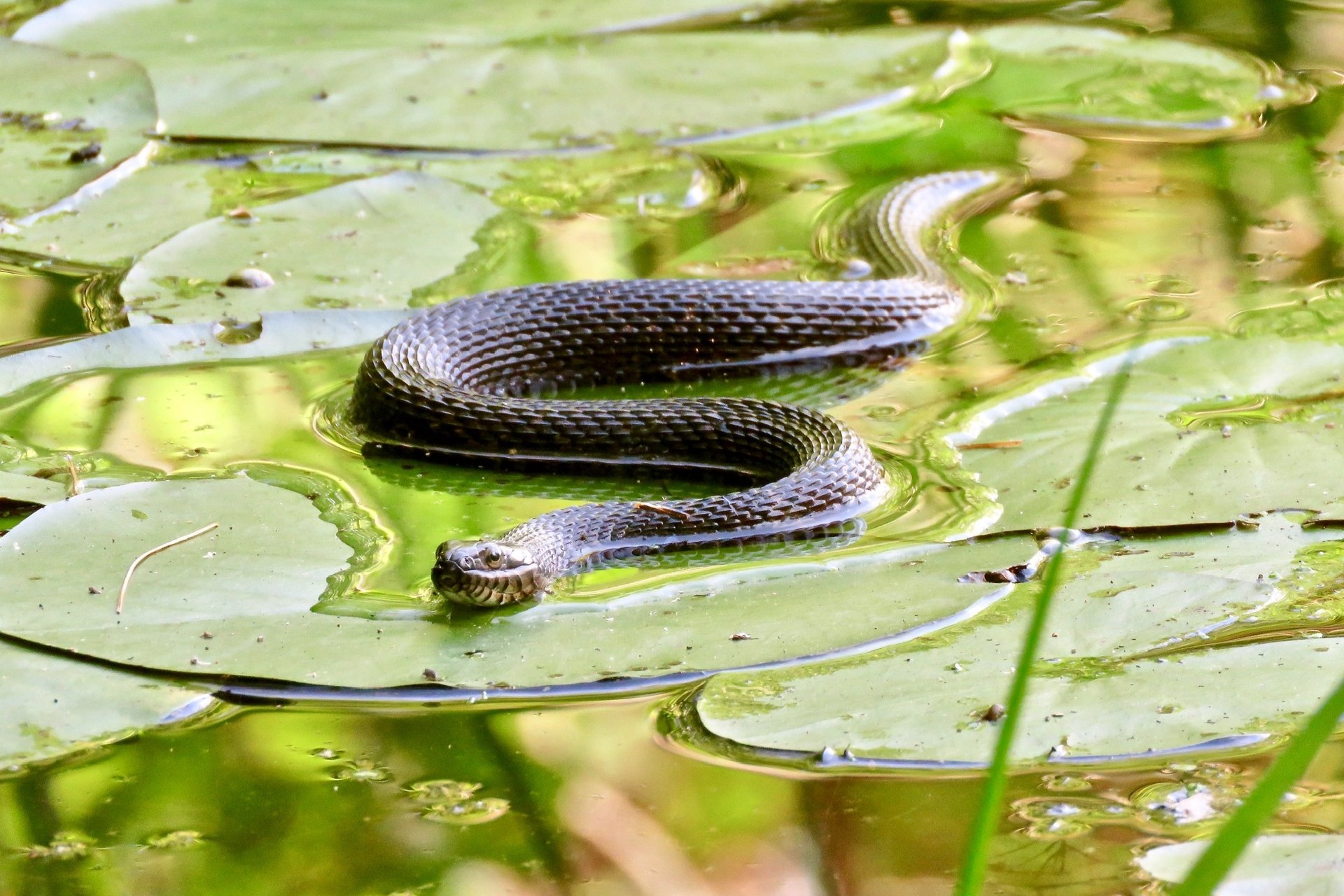
Northern Watersnake (Nerodia sipedon)
The Northern Watersnake can grow large, up to 55” long with heavily keeled scales. It is highly variable in appearance, with a complex, varying pattern of brown, reddish-brown, or black. It’s found in wetlands—you may see it swimming—and it primarily eats amphibians and fish.
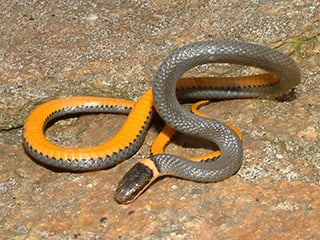
Ring-necked Snake (Diadophis punctatus)
The Ring-necked Snake is named for the yellow ring around its neck. It’s typically found in moist wetlands, where it eats primarily small salamander, but also feeds on worms, insects and slugs. This snake is slender and small, usually measuring from 10-15” long. It has smooth scales and a grey back.
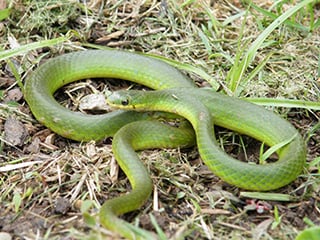
Smooth Greensnake (Opheodrys vernalis)
True to its name, the Smooth Greensnake is smooth and green. It prefers thick foliage areas where it can blend in. This gentle snake eats insects, beetles, and other small creatures.
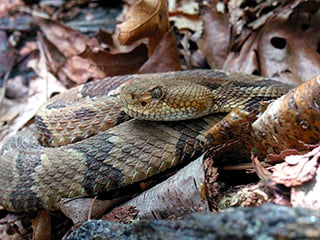
Timber Rattlesnake (Crotalus horridus)
Venomous, the Timber Rattlesnake is extremely rare and localized. It has a heavy body, a triangular head, a slitted, cat-like pupil, and a rattle that it uses to warn potential predators. It prefers rocky, forested areas.
Status: Endangered in Massachusetts, and, under the Massachusetts Endangered Species Act, it is illegal to kill, harass, or possess this snake.
Snake Behavior & Life Cycle
Snakes are ectotherms, which means that they can’t regulate their body temperature from within, as humans do. Instead, they use their environment, basking in the sun to keep warm or slipping underground to cool off.
Snakes breed during the warmer months; most of our species mate in the late spring and have young in the summer. Some species, like the Eastern Milk Snake, lay eggs. Others, like the Timber Rattlesnake, give birth to live young.
In the fall, snakes seek shelter in places like rock crevices and mammal burrows. It’s not uncommon for snakes of different species to den together in the winter.
Snakes never stop growing, and every now and then, they must shed the skin that they’ve outgrown. Younger snakes, which grow more quickly, may shed a few times a year, and mature snakes shed less frequently.
What Do Snakes Eat?
All snakes are carnivores, which means they eat meat. Their diet varies with size and species, and can include insects, worms, amphibians, fish, small mammals, and occasionally birds.
What To Do If You Come Across a Snake
For some people, spotting a snake in the wild is an exciting and special experience, but for others, it may provoke anxiety.
Snakes prefer to avoid people and will generally only bite when they are picked up, stepped on, or otherwise provoked. Though most of our snakes are harmless, several species have defensive displays, like exuding a smelly musk or rattling their tails. These harmless behaviors often cause frightened people to kill the snake.
If you come across a snake while exploring outside, it’s best to give them plenty of room and move on.
Suburban yards can provide good habitat for snakes, which may seek cover under stairways, shrubs, wood piles, stonewalls, and dense vegetation. It’s usually best to leave the snake alone. In rare cases, you may want to act. If the snake is in an inconvenient spot, stomp on the ground in the vicinity of the snake. The vibration will often cause it to move away. You can discourage snakes from sunning on steps or walks by covering those areas with plastic doormats that have a false grass texture.
Are There Venomous Snakes in Massachusetts?
Fortunately, the snakes you’re likely to find in your yard in Massachusetts aren’t venomous. The two venomous species, the Northern Copperhead and Timber Rattlesnake, are endangered, and they prefer rocky, forested hillsides.
Why Are Snakes Important?
Snakes play a crucial role in ecosystems as both predators and prey. They help control pest populations, such as rodents and insects, and serve as a food source for other wildlife, thus maintaining balance within their habitats.
How Mass Audubon Supports Snakes
Mass Audubon works at our wildlife sanctuaries and beyond to ensure that the nature of Massachusetts continues to thrive. By protecting diverse habitats, advocating for conservation policies, and engaging our community, we support these essential reptiles. Learn more about our work
How You Can Support Snakes
Mass Audubon supports wildlife, including snakes, every day, but we couldn’t do it without the support of our 160,000+ members.
Help us support snakes, and reptiles like them, by becoming a member today.
Stay Connected
Don't miss a beat on all the ways you can get outdoors, celebrate nature, and get involved.



